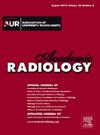光子计数与双源 CT 在经导管主动脉瓣植入术规划中的对比。
IF 3.8
2区 医学
Q1 RADIOLOGY, NUCLEAR MEDICINE & MEDICAL IMAGING
引用次数: 0
摘要
背景:规划经导管主动脉瓣植入术(TAVI)时需要使用心血管 CT:目的:比较光子计数CT(PCCT)与双源CT(DSCT)的图像质量、TAVI计划的适用性和辐射剂量:对 2022 年 1 月至 2023 年 7 月期间接受造影剂增强主动脉-髂-股动脉 PCCT 和/或 DSCT 的主动脉瓣狭窄 TAVI 候选者进行回顾性研究。通过标准化 ROI 分析计算信噪比 (SNR) 和对比度-噪声比 (CNR)。图像质量和 TAVI 计划的适用性由四位独立专家读者(两位心脏放射专家和两位心脏病专家)按 5 分制进行评估。CT剂量指数(CTDI)和剂量-长度-乘积(DLP)用于计算有效辐射剂量(eRD):300 名患者(136 名女性,中位年龄:81 岁,IQR:76-84)接受了 302 次 CT 检查,其中 202 人接受了 PCCT 检查,100 人接受了 DSCT 检查;两名患者同时接受了这两种检查。虽然 PCCT 图像的 SNR 和 CNR 明显低于 DSCT 图像(33.0 ± 10.5 vs. 47.3 ± 16.4 和 47.3 ± 14.8 vs. 59.3 ± 21.9,P 结论:PCCT 提高了图像质量,但也降低了 CNR:与最先进的 DSCT 相比,PCCT 提高了图像质量,有效避免了 TAVI 计划中的非诊断 CT 成像,且辐射剂量更低。放射科医生和心脏病专家认为 PCCT 图像更适合用于 TAVI 计划。本文章由计算机程序翻译,如有差异,请以英文原文为准。
Photon-Counting Versus Dual-Source CT for Transcatheter Aortic Valve Implantation Planning
Background
Cardiovascular CT is required for planning transcatheter aortic valve implantation (TAVI).
Purpose
To compare image quality, suitability for TAVI planning, and radiation dose of photon-counting CT (PCCT) with that of dual-source CT (DSCT).
Material and Methods
Retrospective study on consecutive TAVI candidates with aortic valve stenosis who underwent contrast-enhanced aorto-ilio-femoral PCCT and/or DSCT between 01/2022 and 07/2023. Signal-to-noise (SNR) and contrast-to-noise ratio (CNR) were calculated by standardized ROI analysis. Image quality and suitability for TAVI planning were assessed by four independent expert readers (two cardiac radiologists, two cardiologists) on a 5-point-scale. CT dose index (CTDI) and dose-length-product (DLP) were used to calculate effective radiation dose (eRD).
Results
300 patients (136 female, median age: 81 years, IQR: 76–84) underwent 302 CT examinations, with PCCT in 202, DSCT in 100; two patients underwent both. Although SNR and CNR were significantly lower in PCCT vs. DSCT images (33.0 ± 10.5 vs. 47.3 ± 16.4 and 47.3 ± 14.8 vs. 59.3 ± 21.9, P < .001, respectively), visual image quality was higher in PCCT vs. DSCT (4.8 vs. 3.3, P < .001), with moderate overall interreader agreement among radiologists and among cardiologists (κ = 0.60, respectively). Image quality was rated as “excellent” in 160/202 (79.2%) of PCCT vs. 5/100 (5%) of DSCT cases. Readers found images suitable to depict the aortic valve hinge points and to map the femoral access path in 99% of PCCT vs. 85% of DSCT (P < 0.01), with suitability ranked significantly higher in PCCT vs. DSCT (4.8 vs. 3.3, P < .001). Mean CTDI and DLP, and thus eRD, were significantly lower for PCCT vs. DSCT (22.4 vs. 62.9; 519.4 vs. 895.5, and 8.8 ± 4.5 mSv vs. 15.3 ± 5.8 mSv; all P < .001).
Conclusion
PCCT improves image quality, effectively avoids non-diagnostic CT imaging for TAVI planning, and is associated with a lower radiation dose compared to state-of-the-art DSCT. Radiologists and cardiologists found PCCT images more suitable for TAVI planning.
求助全文
通过发布文献求助,成功后即可免费获取论文全文。
去求助
来源期刊

Academic Radiology
医学-核医学
CiteScore
7.60
自引率
10.40%
发文量
432
审稿时长
18 days
期刊介绍:
Academic Radiology publishes original reports of clinical and laboratory investigations in diagnostic imaging, the diagnostic use of radioactive isotopes, computed tomography, positron emission tomography, magnetic resonance imaging, ultrasound, digital subtraction angiography, image-guided interventions and related techniques. It also includes brief technical reports describing original observations, techniques, and instrumental developments; state-of-the-art reports on clinical issues, new technology and other topics of current medical importance; meta-analyses; scientific studies and opinions on radiologic education; and letters to the Editor.
 求助内容:
求助内容: 应助结果提醒方式:
应助结果提醒方式:


